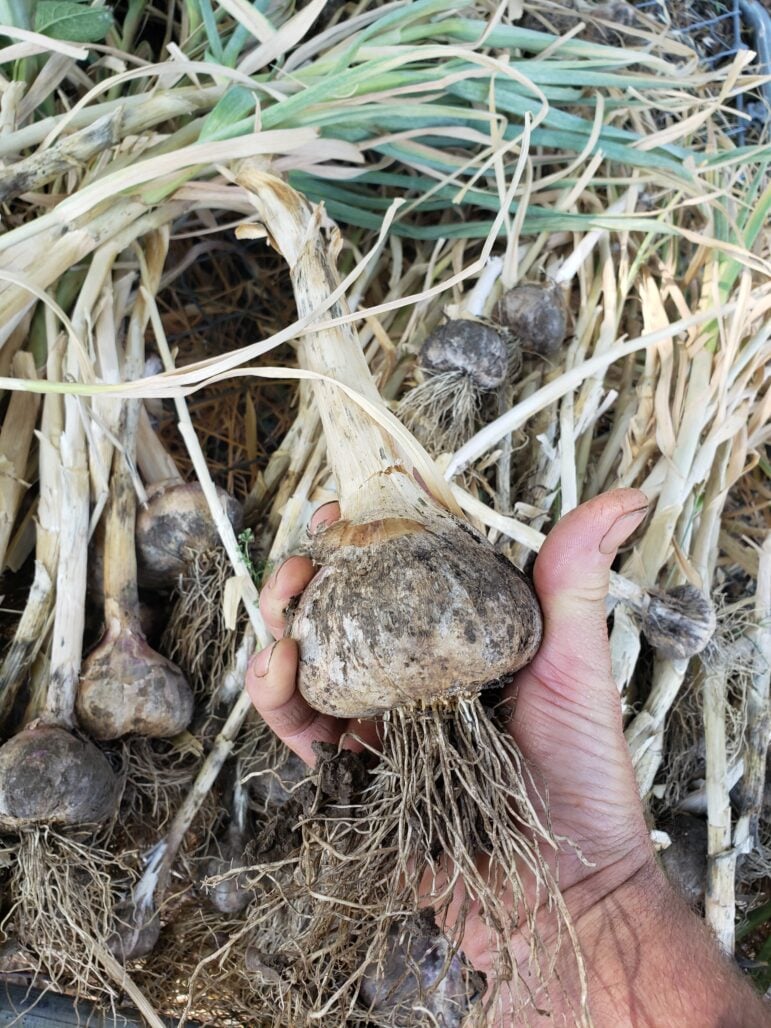This is our farm column from farmer Casey O’Neill. O’Neill is the owner operator of HappyDay Farms north of Laytonville, and a long time advocate for the cannabis community in Mendocino Co; more of his writing can be found here. The opinions expressed in this column are those of the writer. If you would like to submit a letter to the editor feel free to write to [email protected].
Whew, it’s been nice and warm! It’s not hot, because I don’t work when it’s hot, so the logic follows that it can only be nice and warm. These are the long days of summer, when the efforts of the various enterprises rise in thickening cacophony. I put a wet towel with two ice cubes on top of it under my hat and this helps to keep my head cool through the hot (I mean…nice and warm) afternoons.
As the soil dries, the landscape cries out for water. Irrigation becomes both more precious but less effective as the drying land draws water outward, away from the drips. We are still having great success with the double mulch layer, but are also finding that we have to go back and add more in places where it is too thin.
Wild plants have many strategies for survival. Some are drought resistant or deep-rooted enough to manage, while others go dormant. Crops are more tender and need care to survive on our rocky ridgeline. I walk the farm in the afternoon, watching for heat stress and the signs of lacking water in both plants and animals.
I find myself dripping sweat by the time I finish morning chores though it be not long past sunrise. The days begin early and go long, a flowing list of tasks checked off as we move from planting season to tending and harvesting. I expand the shade structures for the poultry out on pasture and sprinkle the pigs sometime after lunch.
This is the year of scavenging water, finding excess or waste in the system and using it to greater benefit. All of the leftover water from produce washing is gathered in 5 gallon buckets that are distributed to perennials that don’t get irrigation. When I change the animal waters each day, I pour the old water into buckets to spread out for bunchgrasses or other perennials in the vicinity.
Overall water usage on the farm is down about 60% from this time last year, but the pond is far lower than it has ever been as we approach the end of June. We have found significant water savings through the heavy mulch, but we are also operating some crops on a tight budget that keeps them hovering just above stress.
We’ll harvest the garlic today, and I’m hoping that I didn’t cut off the water too early. In late April I was certain that we would have the best crop of garlic yet, but as it has dried in the field I’ve become less sure of myself. Farming is so often composed of guesswork that is refined over the years through experience, and it’s easy to get into second-guessing and doubt.

The monkey mind loves to chatter about what I could have done differently, or how I should change in the future. I focus on the work, acting in the moment and ignoring the chatter to listen to the voice in my head that tells me which task to do next. When I operate like this I feel peace and the comfort of effort, the work soothing my mind.
When I experience the voice-of-present-effort it is part of the flow of the moment and I relax into it. Though it is physical work and my body is exhausted at the end of each day, I lean into the effort and push through discomfort. The sweat rolls and I drink gallons of ice water with lemon and electrolytes, covering my skin with my broad hat and old polo button-down shirts.
The work of the season progresses, trellising tomatoes and cucumbers, pruning and caging cannabis, harvesting brassica and clearing the beds for animal forage. As the clearing happens we add compost, alfalfa, cardboard and straw, fallowing until after the rains come. The compost and alfalfa will provide food for soil organisms while the cardboard and straw will shelter the soil from the beating sun. I’ll irrigate once a week or so to make sure there is enough moisture to keep the soil thriving in the cool darkness.
The final planting of early season crops will happen tomorrow after the harvest of a bed of lettuce in the hoophouse makes way for the hot peppers that have been waiting in their pots. The time around the solstice is the down-beat in planting, though this year the rhythm will be different as we move forward.
We won’t be planting fall crops until the rains come because there won’t be enough water to irrigate them if we follow our normal planting schedule. What would be a propagation house full of brassica and other cool weather crops will instead be empty tables awaiting the return of the rain. May it come soon. As always, much love and great success to you on your journey!
Casey O’Neill owns and runs HappyDay Farms, a small vegetable and cannabis farm north of Laytonville. He is a long time cannabis policy advocate, and was born and raised in the Bell Springs area. The preceding has been an editorial column. The Mendocino Voice has not necessarily fact-checked or copyedited this work, and it should be interpreted as the words of the author, not necessarily reflecting the opinions of The Mendocino Voice.




